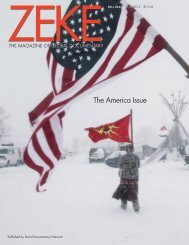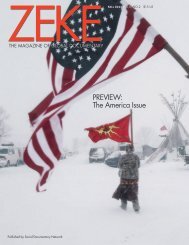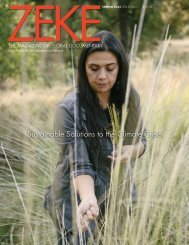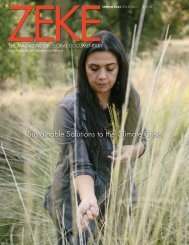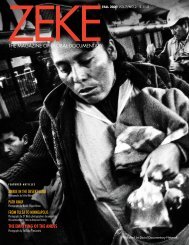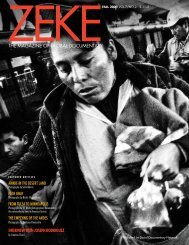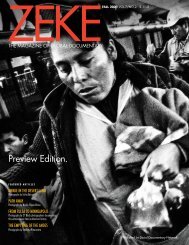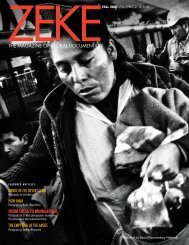ZEKE Fall 2019
Contents includes: "Youth of Belfast" by Toby Binder, and "Delta Hill Riders" by Rory Doyle, winners of ZEKE Award for Documentary Photography "Rising Tides" with photographs by Sean Gallagher, Lauren Owens Lambert, and Michael O. Snyder "Out of the Shadows: Shamed Teen Mothers of Rwanda" by Carol Allen Storey Interview with Lekgetho Makola, Head of Market Photo Workshop, South Africa, by Caterina Clerici "Why Good Pictures of Bad Things Matter" by Glenn Ruga Book Reviews and more...
Contents includes:
"Youth of Belfast" by Toby Binder, and "Delta Hill Riders" by Rory Doyle, winners of ZEKE Award for Documentary Photography
"Rising Tides" with photographs by Sean Gallagher, Lauren Owens Lambert, and Michael O. Snyder
"Out of the Shadows: Shamed Teen Mothers of Rwanda" by Carol Allen Storey
Interview with Lekgetho Makola, Head of Market Photo Workshop, South Africa, by Caterina Clerici
"Why Good Pictures of Bad Things Matter" by Glenn Ruga
Book Reviews and more...
- No tags were found...
You also want an ePaper? Increase the reach of your titles
YUMPU automatically turns print PDFs into web optimized ePapers that Google loves.
Cowboys<br />
BY ZEB<br />
LARSON<br />
Once the 13th Amendment<br />
permanently ended chattel<br />
slavery in the United States,<br />
many of the freemen put<br />
their skills to work by seeking<br />
employment as cowboys.<br />
Many of them remained with<br />
their former masters out of<br />
convenience, and compared to<br />
freed persons who had worked<br />
growing cotton, they enjoyed<br />
far better circumstances. Their<br />
labor was better compensated,<br />
especially because of the<br />
postwar demand for beef and<br />
the absence of white labor in<br />
places like Texas. In the Journal<br />
of Blacks in Higher Education,<br />
African American cowboys<br />
were estimated to be anywhere<br />
between a quarter and a third<br />
of the men who worked the<br />
famous Chisholm Trail. Part<br />
of the cowboy lifestyle in the<br />
South was born out of necessity:<br />
Southern states actively<br />
prevented freed slaves from<br />
purchasing land, and it was<br />
easier to work as a ranch hand<br />
than it was to try and become<br />
a farmer.<br />
The Wild West<br />
However, black cowboys did<br />
not remain confined to the<br />
South. The South was violent<br />
and repressive, and it only<br />
became more so with the end<br />
of Reconstruction and the<br />
return of white segregationist<br />
governments to power. Many<br />
cowboys headed out West to<br />
escape the suffocating racial<br />
mores of the South. To be sure,<br />
the West was no guaranteed<br />
safe haven for cowboys: plenty<br />
of white settlers had moved<br />
west precisely because they<br />
didn’t want to compete with<br />
African American laborers.<br />
However, cowboys could still<br />
leverage the skills that they<br />
had, and because many parts<br />
of the American West remained<br />
poorly settled, accepting their<br />
labor was a necessity.<br />
Defying the World<br />
The era of the Wild West<br />
produced several noteworthy<br />
African American cowboys,<br />
many of whom filled the role to<br />
the hilt. Nat Love, better known<br />
as Deadwood Dick, was born<br />
in Nashville, Tennessee into<br />
slavery. In 1870, he headed<br />
west and ended up in Dodge<br />
City, where he worked on<br />
cattle drives. He later headed<br />
further out west to Arizona.<br />
Like many cowboys, Dick liked<br />
to tell tall tales of his exploits:<br />
he claimed to have been an<br />
expert gunfighter, participated<br />
in cattle drives and<br />
rodeos, and liked to<br />
brag that he rode his horse into<br />
a saloon to order whiskey for<br />
the both of them.<br />
Regardless of how much of<br />
his life was the result of colorful<br />
embellishment, it’s clear<br />
he embraced the cowboy life<br />
because it offered a degree of<br />
freedom. In his autobiography<br />
The Life and Adventures of Nat<br />
Love, written in 1907, Love<br />
spelled out why he liked being<br />
a cowboy. “Mounted on my<br />
favorite horse, my long horsehide<br />
lariat near my hand, and<br />
my trusty guns in my belt…I felt<br />
I could defy the world.” He was<br />
respected among his fellow<br />
cowboys — black and white —<br />
and his employers trusted him.<br />
Rodeos and Riding<br />
The cowboy era of the Wild<br />
West was in decline after 1890<br />
because much of the West had<br />
either been settled or enclosed<br />
through barbed wire: ranchers<br />
no longer needed cowboys<br />
to take cattle on long drives.<br />
This did not mean the end<br />
of cowboy work for African<br />
Americans, however. Even as<br />
the cowboy tradition declined,<br />
its presence in the popular<br />
imagination grew, partly<br />
because of literature, music<br />
and attractions like rodeos or<br />
Wild West shows. The former<br />
showcased cowboy skills like<br />
riding and lassoing, while<br />
the latter helped to create the<br />
idea of the mythologized West<br />
through staged gunfights and<br />
trick shows.<br />
African American cowboys<br />
also helped to create the idea<br />
of a cowboy in the public<br />
imagination. Deadwood Dick<br />
allegedly got his name from<br />
participating in one such rodeo<br />
in the town of Deadwood,<br />
South Dakota (he also claimed<br />
to be a record-holder for breaking<br />
a horse in nine minutes).<br />
The African American cowboy<br />
Bill Pickett, also known as the<br />
Dusky Demon, was responsible<br />
for helping to invent<br />
another rodeo tradition: steer<br />
riding. Pickett was a cowboy<br />
in Oklahoma who invented a<br />
practice known as “bulldogging”<br />
to wrestle steers to the<br />
ground: he would jump from<br />
a horse, grab the steer by the<br />
horns, and bite it on the lip to<br />
force it to the ground. Pickett<br />
became famous and toured<br />
with the likes of Buffalo Bill<br />
Cody until his death in 1932.<br />
Today, the tradition of<br />
African American cowboys<br />
survives through rodeos and<br />
other public exhibitions. The<br />
Bill Picket Invitational Rodeo is<br />
an all-black touring rodeo that<br />
is now entering its 34th year<br />
of operations. Young cowboys<br />
are drawn to it for a variety<br />
of reasons. A young rider in<br />
Charleston, Mississippi told<br />
me how he got into riding:<br />
he wanted to impress a girl<br />
for prom by showing up on<br />
a horse. For him, riding a<br />
horse offers the same sense of<br />
tranquility it offered Nat Love:<br />
“It was kinda like a peace-ofmind,<br />
it was a runaway place<br />
from me. Just coming out of<br />
high school, trying to figure out<br />
life. It was a different feeling<br />
and I still use it as a runaway<br />
place. It’s just a peace place.<br />
The horse will get your mind<br />
out of whatever’s going on.”<br />
<strong>ZEKE</strong> FALL <strong>2019</strong>/ 25









